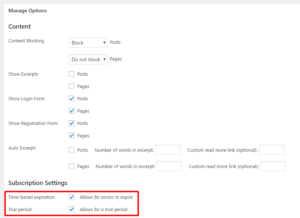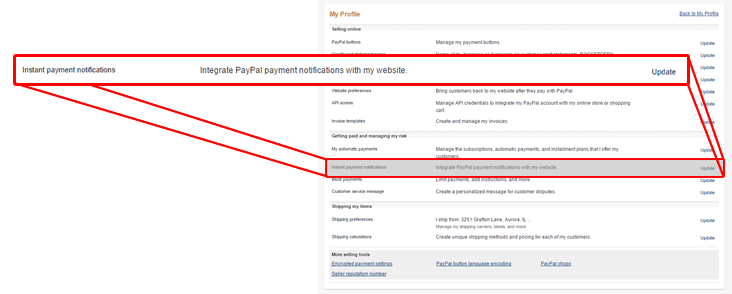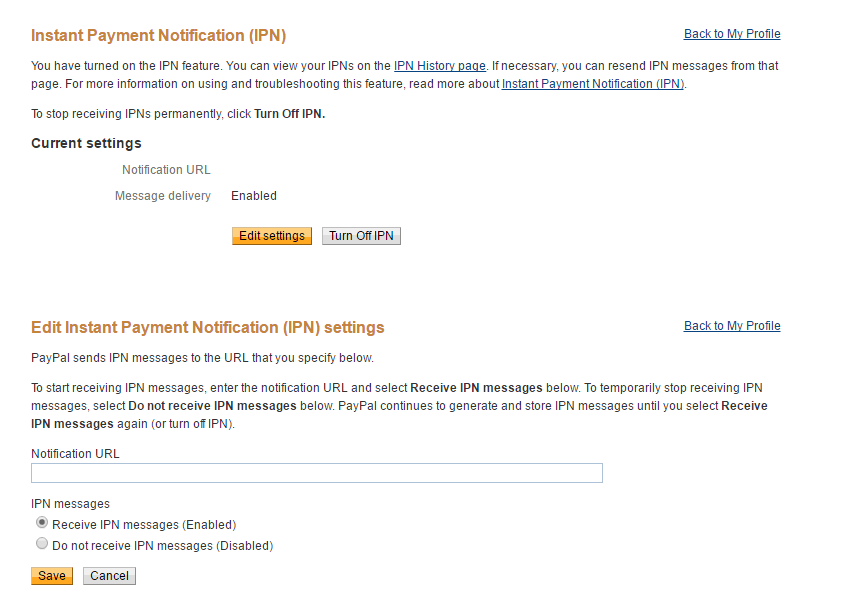The PayPal Subscription extension allows WP-Members to limit a user to a specific subscription period and allows you to charge for subscriptions using PayPal’s IPN.
This extension is available with the WP-Members Pro Bundle, WP-Members Lifetime Support, or is also available individually.
Note: The PayPal Extension requires the PHP cURL library be enabled. If you are not sure what this is or if it is enabled, check with your host.
- Registration and Payment Flow
- Installation
- Setting Up the Extension
- IPN Log File
- Manage Users
- PayPal IPN Configuration
- PayPal Developer Tools
- Filter and Action Hooks
Registration and Payment Flow
The PayPal subscription extension utilizes the PayPal Instant Payment Notification (IPN) system to notify your site that a user has paid and to extend their subscription expiration date accordingly.
The registration flow when using the extension is as follows:
- User registers on your site, a new user account is created and login credentials are emailed to the user
- Upon successful registration, the user is presented a PayPal button to take them to PayPal to complete payment
- Upon successful payment, the user is returned to your site
It is important to note that while a user account is created for the user, they are unable to view any restricted content until their payment is processed by PayPal and the IPN is successfully passed. The user is still able to log in and view their profile which will indicate that they have not completed payment. This way, if they leave the registration process without completing payment they can return to complete payment later. Until they actually complete payment, they will not be able to view any restricted content. Instead, they will be presented with a message indicating they need to complete payment and a PayPal payment button.
Installation
This extension installs as a plugin. Download the installation package as a zip file, then use the new plugin uploader or unzip the package and FTP transfer to your plugin’s folder.
Once the extension is installed, go to Plugins > Installed Plugins to activate.
Setting Up the Extension
To set up the PayPal Subscription extension go to the WP-Members Options tab and indicate that you are using time-based expiration. You will notice that with the inclusion of the extension, there are two additional settings available; one for time-based expiration and the other for offering a trial period. Select trial period only if you are offering a trial period for your subscription. These settings are highlighted in red in the image to the right.
Next, configure the extension’s options. These are found in the Subscriptions tab.
 Set the time period, price, and name for your trial period (if used) and regular subscription period. Indicate the currency the price is in, and the type of transaction you will use (basic/regular billing or automated recurring billing).
Set the time period, price, and name for your trial period (if used) and regular subscription period. Indicate the currency the price is in, and the type of transaction you will use (basic/regular billing or automated recurring billing).
Important: Recurring billing is not available for personal PayPal accounts. You must have a business account to use recurring billing.
You will need to indicate your PayPal User ID and whether this is live or sandbox. Your PayPal User ID is the primary email address associated with your account. It will not be a merchant ID which would be a series of numbers and/or letters.
Note the following:
- If you are using the sandbox for testing, the PayPal User ID MUST be that of a sandbox user account, NOT your regular PayPal ID.
- It is important to make sure you are using the primary email address associated with the account. The IPN process validates the user receiving the payment. This comparison is done against the ID of the account. If you use a secondary email in this setting, the validation will fail.
It is highly recommended that you test your setup with the PayPal sandbox prior to going live. This will allow you to make sure that PayPal can find your IPN listener and that the IPN listener if functioning correctly.
If you have difficulty getting transactions to work in the sandbox, you may wish to enable logging with the toggle in the settings. This will allow you to gain some additional information on what is being sent through the IPN. An additional testing step may include using the PayPal IPN simulator (more on this in the section on the PayPal developer tools below).
If you want to include a login page for the return from PayPal, set this page in the optional setting.
If you are not using a free trial, it is recommended that you set the extension’s settings to display the PayPal payment button in the successful registration message.
IPN Log File
You may enable basic logging for tracking problems with the IPN by checking “Enable logging” in the extensions settings tab. This will create a log file for you in the plugin’s folder. As data is written to the log, it will be displayed on the plugin’s settings tab below the settings. Essentially, it will indicated the time of the transaction, the status, and the action (which should indicate the user ID and that the user’s expiration date was moved forward).
It is not recommended that you continue to use the log file on a live system once you know you have things functioning. This is primarily for debugging potential IPN issues. You should use it when using the sandbox, and maybe when you first set up live transactions just to verify you are working.
You can clear the log file by checking the box “Clear Log File” and submitting.
When you are finished with the log file, you can delete it. Turning off logging will also remove the log file.
In instances where a complete log of all IPN information is needed (usually only in the case of troubleshooting difficult issues), “verbose” logging can be enabled using the wpmem_exp_ipn_defaults filter hook.
IPN Log File Error Messages
The log file will alert you to specific errors that may occur in a transaction. The are the following:
- Emails did not match – if the email used for the PayPal ID is not the primary email on the PayPal account, an error will be returned and the transaction will not be processed. This is the most common type of error reported. Make sure that you use the primary email for the PayPal ID. This prevents the transaction from being hijacked.
- Price did not match – this also prevents tranaction hijacking. If the price in the transaction did not match the price in the settings, the transaction will be halted. Note that if you are customizing for multiple prices, you do need to make some adjustments so that this error is not triggered (see “workaround for price validation” here).
- Transaction was not complete or a refund – there are multiple types of transactions the IPN can handle. We are only concerned with a complete purchase or a refund. All other transaction types are ignored.
- No transaction ID – if there is no transaction ID, the process will not continue.
Manage Users
Individual User Profile
The extension adds a line to the WP-Members custom fields in the individual user profile to indicate the user’s subscription status.
When the user first signs up, they will be listed as pending until they complete payment.
Once the user completes payment, it will indicate their subscription status (subscription or trial) and their expiration date.
In all cases, you have the option of extending their expiration date or expiring the user. Expiring the user will set their expiration date to now minus one day.
Bulk User Actions
Users can be expired from the bulk users actions available on Users > All Users. You can also expire individual users from the user table as the extension adds an expiration link to the hover menu. Expiring the user will set their expiration date to now minus one day.
Delete Pending Users
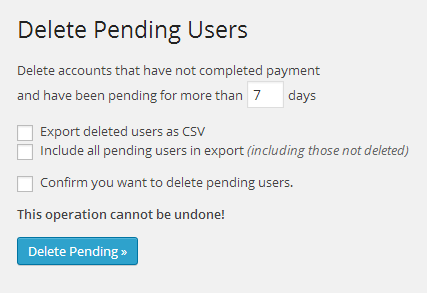 To delete users that are older than X days old, select Users > Delete Pending in your WP admin menu.
To delete users that are older than X days old, select Users > Delete Pending in your WP admin menu.
You may also select to export the list of users that you delete as a CSV (select “Export deleted users as CSV”).
If you want your export file to include ALL pending users – those deleted and also those that are not deleted – select “Include all pending users in export.” Those users that are deleted will be marked as such in the export file.
Because this involves the deletion of users from the database, you must confirm that you intend to execute this action.
PayPal IPN Configuration
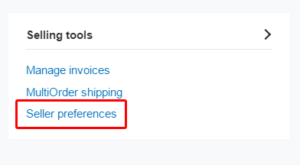 You will need to turn on IPN in your PayPal account and set the location of your IPN listener.
You will need to turn on IPN in your PayPal account and set the location of your IPN listener.
Depending on your PayPal account type, you should see a select for “Seller Preferences” on your main page. This will likely be on the left hand side under a menu heading “Selling Tools.” Click on “Seller Preferences” to get to the Seller Preferences screen.
This should give you your account profile. One of the line options should say “Instant payment notifications” with a link to update your settings.
When you click update, you will have a screen that indicates your IPN settings. Make sure IPN is turned on! If there is no notification URL, or it does not match the location indicated in the extension’s subscriptions tab, click edit settings and add this location in the Notification URL box. The image below shows these two screens. Again, make sure you’ve entered the correct IPN listener location for notifications and that you have enabled IPN messages.
PayPal Developer Tools
It is highly recommended that you test your setup with the PayPal sandbox. You use this by going to http://developer.paypal.com and creating a developer account. Once you have an account, you can login and go to Applications > Sandbox Accounts.
In the sandbox, you will need to create at least two accounts, one for the merchant and one for the buyer. Use the merchant for the User ID in the extension’s settings when you are testing with the sandbox. Use the buyer account to “pay” for the subscription when testing the registration process. That test user should receive a valid transaction and have their expiration date set according to your subscription period. If so, good – you can go live. If not, then you should do additional testing to see why the transaction did not work.
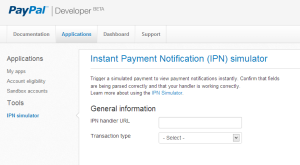 You can also use Applications > IPN Simulator to send a simulated IPN transaction without actually registering a user. This will allow you to determine if PayPal can see your IPN and the IPN is properly functioning.
You can also use Applications > IPN Simulator to send a simulated IPN transaction without actually registering a user. This will allow you to determine if PayPal can see your IPN and the IPN is properly functioning.
Using the IPN Simulator
There are two tests for the IPN Simulator. The first is a quick test to verify that the IPN listener can respond to the system. This is to verify the “handshake.” This will tell you if PayPal can see and connect to your listener.
- Get the IPN handler URL from the extension’s settings tab under IPN Location.
- Paste that into the handler URL.
- Select “Web Accept” for the transaction type.
There will be a large amount of options in the form. You can leave all of these as-is if you are just testing to make sure the IPN handshake can be verified.
Send through this test with just the defaults. You should get an indication of a valid IPN test if it finds the listener and the listener responds. If not, you may need to troubleshoot why it can’t find the listener. (NOTE: your test site MUST be out in the open for this to work and the domain must be valid. If you are testing on localhost or some test system that is not open, PayPal won’t be able to see it and you won’t be able to test it).
If the handshake is verified and things are working, you can send a more detailed test to make sure that user expiration dates can be set appropriately. Use the same settings as 1-3 above, and add the following:
- Under the heading “Payment Information” set “payment_status” to “Completed”.
- Under the heading “Basic Information” set “receiver_email” to the value you have in the extension’s settings for “PayPal User ID”.
- Under the heading “Currency and Currency Information” set “mc_gross” to the value you have in the extension’s settings for “price” (make sure they match exactly). Also, make sure the currency used is the same as what you have set in the extension’s settings. These may default to USD on either side so match them up.
- Choose a specific user ID from your test system. That would be the numeric user_ID of a registered user on your test site. Under the heading “Advanced and Custom Information” set “custom” to this user ID.
If you get a successful IPN transaction, then take a look at the user’s expiration in their profile. You should see the expiration advance by one unit of time.
Once you’ve tested the IPN and it works, you can go live and use your regular PayPal ID (should be an email address – not a numeric merchant account number).
Filter and Action Hooks
The following is a list of hooks that are in the extension.
Filters
- wpmem_exp_experiod
- wpmem_exp_paypal
- wpmem_exp_success_msg
- wpmem_exp_expired_msg
- wpmem_exp_sc_expmsg
- wpmem_payment_form
- wpmem_payment_form_msg
- wpmem_paypal_html_variables
- wpmem_payment_button_args
- wpmem_payment_button
- wpmem_exp_ipn_defaults
- wpmem_exp_reminder_interval
- wpmem_exp_experiod_max
- wpmem_exp_ipn_logfile
- wpmem_exp_curl_options
- wpmem_exp_ipn_defaults
Actions
- wpmem_exp_after_set_exp
- wpmem_ipn_start
- wpmem_ipn_validation
- wpmem_ipn_success
- wpmem_ipn_invalid
Some Customization Examples
- Configure the PayPal extension for multi-unit pricing
- Configure the PayPal extension for multi-tiered pricing
- Change date display format in PayPal extension
- Push user directly to PayPal
- Set user forum access when using bbPress with the PayPal subscription extension
- PayPal Subscription Extension Bulk Extend Users Snippet
- Use an invitation code with the PayPal subscription extension
- Displaying the post access level when using the PayPal addon
- Utility function to determine if a user registration is pending with the PayPal addon
Get the Extension
You can purchase a license for this plugin in the RocketGeek.com Store.
